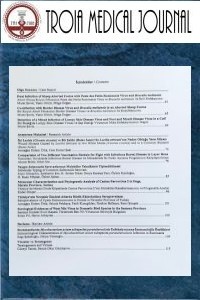Kronik sigara içiciliğinin EKG parametrelerine etkileri
sigara, nikotin, Tp-e/QT oranı, Tp-e/QTc oranı, Tp-e aralığı, ventriküler aritmojenez
Effects of chronic smoking on ECG parameters
smoking, nicotine, Tp-e/QT ratio, Tp-e/QTc ratio, Tp-e interval, ventricular arrhythmogenesis,
___
- 1. Walton K, Wang TW, Schauer GL, et al. State-specific prevalence of quit attempts among adult cigarette smokers - United States, 2011-2017. MMWR Morb Mortal Wkly Rep 2019;68(28):621-6.
- 2. Heart Disease and Stroke, Smoking & Tobacco Use, CDC. https://www.cdc.gov/tobacco/basic_information/health_effects/heart_disease/index.htm. Accessed on Jan 10, 2022.
- 3. Taşolar H, Balli M, Bayramoğlu A, et al. Effect of smoking on Tp-e interval, Tp-e/QT and Tp-e/QTc ratios as indices of ventricular arrhythmogenesis. Hear Lung Circ 2014;23(9):827-32.
- 4. Ilgenli TF, Tokatli A, Akpinar O, Kiliçaslan F. The effects of cigarette smoking on the Tp-e interval, Tp-e/QT ratio and Tp-e/QTc ratio. Adv Clin Exp Med 2015;24(6):973-8.
- 5. D’Alessandro A, Boeckelmann I, Hammwhöner M, Goette A. Nicotine, cigarette smoking and cardiac arrhythmia: an overview. Eur J Prev Cardiol 2012;19(3):297-305.
- 6. Gupta P, Patel C, Patel H, et al. T(p-e)/QT ratio as an index of arrhythmogenesis. J Electrocardiol 2008;41(6):567-74.
- 7. Kors JA, RitsemavanEck HJ, vanHerpen G. The meaning of the Tp-Te interval and its diagnostic value. J Electrocardiol 2008;41(6):575-80.
- 8. Erikssen G, Liestøl K, Gullestad L, Haugaa KH, Bendz B, Amlie JP. The terminal part of the QT interval (T peak to T end): a predictor of mortality after acute myocardial infarction. Ann Noninvasive Electrocardiol 2012;17(2):85-94.
- 9. Smokerlyzer ® Range for use with piCO, piCO baby and Micro +, user manual. https://www.bedfont.com/documents/smokerlyzer-manual.pdf. Accessed on 17 Apr, 2021.
- 10. Ulubay G, Dilektaşlı AG, Börekçi Ş, et al. Turkish Thoracic Society Consensus report: interpretation of spirometry. Turkish Thorac J 2019;20(1):69-89.
- 11. Tanaka T, Yahagi K, Asami M, et al. Prognostic impact of electrocardiographic left ventricular hypertrophy following transcatheter aortic valve replacement. J Cardiol 2021;77(4):346-52.
- 12. Ip M, Diamantakos E, Haptonstall K, et al. Tobacco and electronic cigarettes adversely impact ECG indexes of ventricular repolarization: implication for sudden death risk. Am J Physiol Heart Circ Physiol 2020;318(5):1176-84.
- 13. Wang H, Shi H, Zhang L, et al. Nicotine is a potent blocker of the cardiac A-type K(+) channels. Effects on cloned Kv4.3 channels and native transient out ward current. Circulation 2000;102(10):1165-71.
- 14. Yashima M, Ohara T, Cao JM, et al. Nicotine increases ventricular vulnerability to fibrillation in hearts with healed myocardial infarction. Am J Physiol Heart Circ Physiol 2000;278(6):2124-33.
- 15. Mehta MC, Jain AC, Mehta A, Billie M. Cardiac arrhythmias following intravenous nicotine: experimental study in dogs. J Cardiovasc Pharmacol Ther 1997;2(4):291-8.
- 16. Zareba KM, Truong VT, Mazur W, et al. T-wave and its association with myocardial fibrosis on cardiovascular magnetic resonance examination. Ann Noninvasive Electrocardiol 2021;26(2):e12819.
- 17. Leone A. Biochemical markers of cardiovascular damage from tobacco smoke. Curr Pharm Des 2005;11(17):2199-208.
- 18. Skipina TM, Upadhya B, Soliman EZ. Exposure to secondhand smoke is associated with increased left ventricular mass. Tob Induc Dis 2021;19:43.
- ISSN: 2630-6107
- Yayın Aralığı: Yılda 3 Sayı
- Başlangıç: 2019
- Yayıncı: Çanakkale Onsekiz Mart Üniversitesi
Kronik sigara içiciliğinin EKG parametrelerine etkileri
Muhammet KIZMAZ, Funda GÖKGÖZ DURMAZ, Mehmet Emre AY, Burcu KUMTEPE KURT, Ezgi DÖNER
Influenza B enfeksiyonu sırasında gelişen akut selim çocukluk çağı miyozit olgusu
Beste DEVRİL, Taylan ÇELİK, Hakan AYLANC
Uğur KÜÇÜK, Bahadır KIRILMAZ, H. Fatih AŞGÜN, Ercan AKŞİT
Koroner arter hastalığında epikardiyal yağ doku indeksinin araştırılması
Mehmet ARSLAN, Ercan AKŞİT, Hasan BOZKURT, Başak KORKMAZER, Erkan Melih ŞAHİN
Sevil ALKAN, Duygu SIDDIKOĞLU, Sinem SEFER, Zeynep İdil DURMUŞ, Loutfi KECHAGİA, Cihan YÜKSEL
Murat TEKİN, Musa UYSAL, İbrahim UYSAL, Aycan ÇOLAK UYSAL, Çetin TORAMAN
Çanakkale ilinde bir erişkin ülseroglandüler tularemi olgusu
Safiye Bilge GÜÇLÜ KAYTA, Sevil ALKAN, Taylan ÖNDER, Anıl AKÇA, Cihan YÜKSEL, Servan VURUCU, Alper ŞENER, Ebru DOĞAN
Brusellozun nadir ve atipik sunumu: Akut batın
Serhat KARAAYVAZ, Oruç Numan GÖKÇE
Rabdomiyoliz: COVID-19’un nadir bir sunumu
